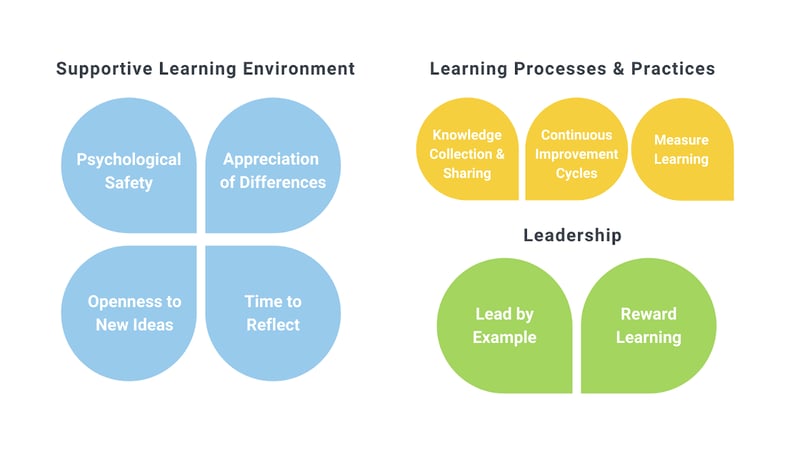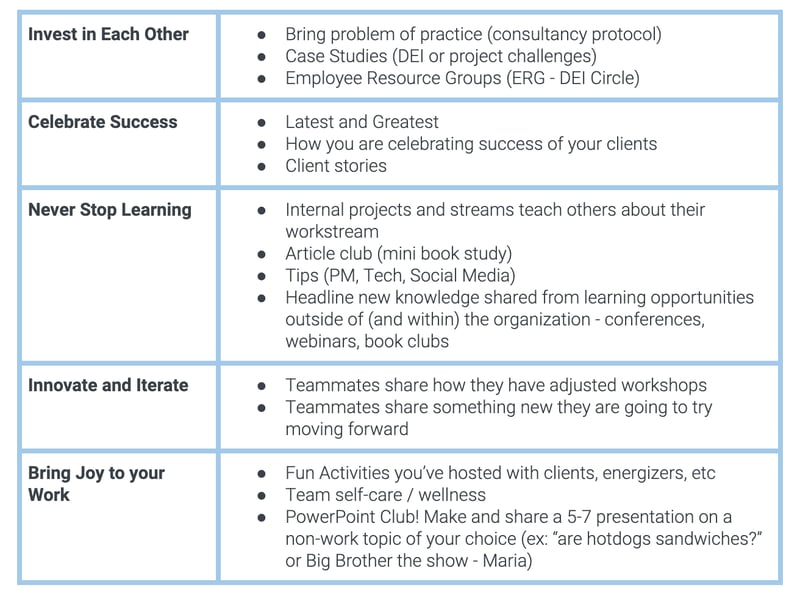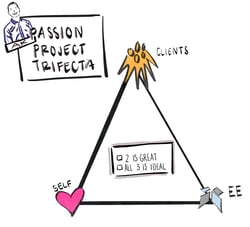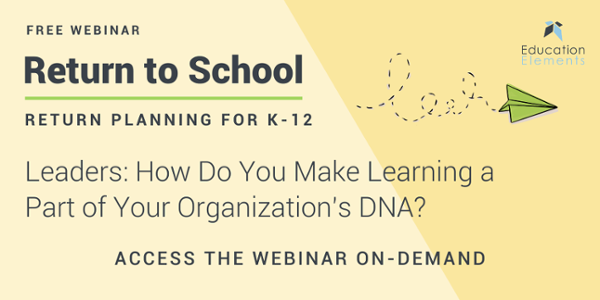
By: Andreea Mitran, Drew Schantz, Jill Thompson, and Kelly Freiheit on June 17th, 2020
How to Practice and Promote a Culture of Learning
Organizational Leadership & Change Management | District Leadership
In times of uncertainty, organizations tend to shift their focus to getting results, maintaining order, and ensuring safety. While these actions make sense to counteract the challenges of complexity, it is in fact a culture of learning that allows organizations to increase agility and heighten their ability to navigate uncharted waters.
A 2008 article by David Garvin, Amy Edmonson, and Francesca Gino in the Harvard Business Review outlines three fundamental building blocks for organizations that want to prioritize a culture of learning. Below, we’ve broken down those building blocks into their respective subcomponents and connected each of them to specific practices you can apply to work in your school or district right away.

Supportive Learning Environment: How does Education Elements create and sustain a supportive learning environment for its team members?
Psychological Safety
In 2016, Google embarked on a research project, code-named “Project Aristotle” (a tribute to Aristotle’s quote, “the whole is greater than the sum of its parts,”) to understand what makes a great team. After undergoing a variety of studies, hundreds of interviews, and parsing through thousands of data points, the researchers found that the effectiveness of a team wasn’t as much about who was on the team, but rather, how the team worked together. At the top of the list of team best practices was establishing a sense of psychological safety, or the belief that a team is safe for risk taking in the face of being seen as ignorant, incompetent, negative, or disruptive. They found that teams with high levels of psychological safety enabled team members to feel confident that no one on the team would embarrass or punish others for admitting a mistake, asking a question, or offering a new idea.
If you’ve worked with us before, you know that at Education Elements, we practice establishing psychological safety through the check-in question. While it might have taken some getting used to when first getting started on the team, I don’t know how I could host a meeting (or even a Thanksgiving dinner with their families — really, you should try it) without one. Essentially, the check-in question allows participants in a gathering to contribute their voice to the conversation before any decisions get made. This allows everyone to be present, showcase engagement early, and also learn something about other members of the team. Check-in questions can range from silly (what does your favorite shape of pasta say about you?) to serious (what is taking up the most mental energy for you right now?). If you want to do one small thing that will yield powerful results, try the check-in question during your next meeting. You can find a list of check-in/out questions here to get started.
Appreciation of Differences
All teams experience at least some degree of tension among their members — often tied to competing or differing viewpoints. We’ve been trained to believe that this type of tension is a negative thing. However, what we’ve observed at Education Elements is that teams with processes in place to address tension, or a space to have ongoing conversations about different ideas end up learning faster as a team. What if we focused our attention on developing common language and using a protocol to address tensions vs. worrying about the outcome of how teammates might feel if disagreement occurs?
It’s essential to remember as we are making decisions, brainstorming new ideas, or developing the next roadmap for a project, we have to remember that teams need to do what’s in the best interest of the organization. An honest and well-intentioned rejection of an idea gives a team the permission to explore a better solution that better fits the bill. The key is creating psychological safety within a team where teammates appreciate lines of difference. At Education Elements, we often use the “objection / no objection” protocol as a simple way to manage this tension, and we encourage you to develop the practice as a team as well.
Openness to New Ideas
As humans, our bodies are trained to reject things to which we aren’t accustomed. It’s easy to say “no” if something feels like a threat to the current status quo. On our team, we’ve recognized that we need to be on a constant pursuit for new ideas to continue to grow and learn. It’s normal to be afraid of the unknown — but what if you created an environment in which you don’t have to be? Trying new things that push you out of your comfort zone can help you and your organization grow. At Education Elements, we practice “failing forward.” This means that we are more open to ideas because we know we’ll learn from our mistakes and continue to grow. What does this look like in practice? When we have, or are presented with a new idea, we are encouraged to first ask ourselves, “is it safe enough to try?” In other words, we are looking to see if this new idea can be tested in a way that minimizes substantial risks and allows progress to be made towards answering a larger question.
“When staff and school teams work with the new rule of aim for “safe enough to try”...instead of consensus, it can become a mantra that empowers teams to take action.” - Anthony Kim and Alexis Gonzales- Black, The New School Rules
Failing forward and activating solutions that are safe enough to try make it easier to give life to a new idea. Try using this with your team when you’re presented a new idea and let us know how it goes in the comments.
Time to Reflect
Reflection is something that we practice at Education Elements in a few different ways. One way reflection is encouraged is through individual daily reflection practices. At the end of each day many of our teammates take 10 minutes to jot bulleted notes around three themes: what I learned today, what big ideas am I thinking about, and what I want to accomplish tomorrow. This process helps our teammates to not think about their day purely as a time to get things done, but also a time to intentionally learn and grow as a professional. A second way we reflect at Education Elements is with our Professional Development Advisors (PDA). The PDA program’s objective is to use a consistent support structure to personalize development for each team member to achieve their short-term and long-term career goals. Typical PDA meetings occur anywhere from bi-weekly to monthly and give everyone the space to reflect on the unique value they bring to the company. A third way we reflect at Education Elements is through project stepbacks. At the conclusion of a scope of work with a district, or even part-way through, we reflect on things that went well and things that should improve moving forward. We share these insights through in-person conversations, notes documents, and in our Slack channels. This type of reflection takes on many forms and happens in a variety of ways, but ultimately allows us to constantly iterate and improve on our work to better meet the needs of the schools and districts we work with.
Learning Processes & Practices: How does Education Elements promote sharing, measurement, and continuous learning cycles within the organization?
Knowledge Collection and Sharing
One of the first things that falls to the wayside when you’re against the clock is the intentional collection and sharing of knowledge within your organization. We have found that the practice of placing knowledge sharing as an agenda item frequently or as an objective for a meeting can help you and your team keep it top of mind.
If you’re wrestling with whether or not it’s worth the time and effort to consider adding it to your next meeting, here is how we’ve seen intentional knowledge sharing benefit school districts we work with.
- Sharing knowledge promotes creativity: District and school leaders are constantly asked to generate new ideas. If you have knowledge sharing as a regular part of ongoing conversations, people are able to adapt faster and react more quickly to new information coming at them. We’ve found it minimizes the knowledge gap and allows teams to collectively explore different perspectives.
- Sharing knowledge encourages active participation: Leaders have been able to turn their passive two-hour meetings with their teams into a space that’s memorable by allowing the flow of new information and reduces the risk of assimilated knowledge.
- Sharing knowledge enhances happiness across a team: Teams are able to build each other up by providing the intimate space for teammates to feel empowered to bring knowledge to the team. This practice of sharing learnings builds psychological safety and confidence which ultimately impacts individuals' sense of belonging on a team.
The Design & Implementation Team at Education Elements has a weekly practice during their Friday meetings where they identify 1-2 people to share learnings with the rest of the team. They are connected to our core values as an organization.

Sample of How Our Core Values Align to our Weekly Learning
Continuous Improvement Cycles
We consistently give our teammates at Education Elements feedback at least twice a year during our feedback cycles. Oftentimes you will see teammates asking for feedback more often than that. We often tell others our goals and ask for them to give specific feedback on those goals. For example when I was working on asking better questions, I would ask my Ed Elements teammates to provide me with feedback on how I did with my questioning during a call or session with one of our district partners. This always helps me to get direct feedback in real time based on my needs.
Measure Learning
One of the reasons we may be afraid to try things is the risk of failure. But what if failure was baked into the plan? At Education Elements, we’re encouraged to try mini-experiments before we set them into practice. This is how many of our service lines were created. We set up hypotheses, test them, and review our “experiment” to see what we can continue doing, what we should stop doing, and what we should start doing. While we don’t formally test ourselves on what we’ve learned, we make sure we return to our original hypothesis after we’ve tested it. We reflect on everything we’ve accomplished, and how we can do it better next time. This information is useful when we’re identifying what new and specific action steps can be taken to pivot our approach, how our roles or accountabilities can change based on new information, and how to continuously improve our process.
Leadership: What role do leaders play in promoting a culture of learning at Education Elements?
 Lead by Example
Lead by Example
Our CEO, Anthony, is always modeling learning for us at Education Elements. He practices what he preaches by sharing his learnings with us through his weekly blog, his daily tweets and in our internal meetings. He always pushes us to think about what our passions are and how we can leverage them to better help others and/or the company, he calls this the passion trifecta.
Reward Learning
When asked about her favorite season, television’s beloved Moira Rose (if you know, you know), responded with “Awards.” Everyone loves to be recognized for their efforts. As leaders, we often recognize accomplishments and put a prize ribbon on perfection, but recognizing the tremendous amount of learning that goes into our work is just as important. Instead of purely shouting out successes, could we place an equal emphasis on growth? What if one staff meeting every month could be repurposed as “The Emmys/Tonys/Grammys/Oscars of Learning,” in which team members are recognized for their ability to fail forward and apply lessons learned from their mistakes to a future success story? At Education Elements, we do this on a weekly basis during our all-hands meetings. For each of our core values (one of which is “never stop learning”), members of our team have the opportunity to shout others out for demonstrating that core value in the past week. If learning is to be valued, it should also be celebrated and rewarded. Maybe not with a gold trophy, but a simple acknowledgement can go a long way.
At Education Elements, we recently developed a team (we call them a sub-circle as part of our responsive organization practices) to support aligning tools and resources that will allow our entire company to thrive by sharing best practices in support of our service offerings. We’ve found that our sub-circle is beginning to thrive because we’ve built a culture of healthy and rich dialogue around what it means to be a learning organization at Education Elements. These building blocks have been a foundation for conversations as our organization continues to grow alongside the valuable partnerships with districts and schools we have established over our history.
Next Step: See how the building blocks for a learning organization stack up for your team or organization by taking this survey. The results will provide a starting point to help you assess how well your organization meets the criteria for being a learning organization, especially in comparison to the research done by Harvard Business Review that we mentioned at the beginning of this post.
For a deeper dive into developing a culture of learning at your organization, join our upcoming webinar!


